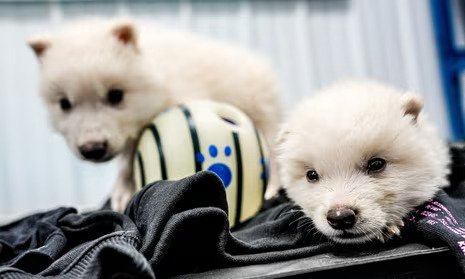If an American biotech company – Colossal Biosciences – is to be believed, scientists at this enterprise have brought dire wolf back from extinction. Yes, by using biotechnology and genetic engineering, the institution has breathed life back into a species that went extinct around 13,000 years ago. Though some are overjoyed thinking that humans can finally atone for their sins by bringing extinct species back to life, others are not excited for reasons related to ethics and veracity of Colossal’s claims.
In a “de-extinction” experiment, Colossal Biosciences has succeeded in reviving a species of canine that is about the same size as that of a modern grey wolf but was native to America some 10,000 years ago. This company that endeavours to bring back the woolly mammoth, Tasmanian tiger and the dodo back to life, has claimed that using genetic engineering, dire wolf is back to reality. The company’s chief scientific officer, Beth Shapiro, said that its tam of scientists extracted DNA of dire wolf from a 13,000-year-old tooth and 72,000-year-old inner ear bone of a dire wolf skull, and used sequenced the DNA to assemble the genomes. The team identified grey wolf as the member closest to dire wolves as their DNA are almost 99.5% identical. The cells of a grey wolf were altered to give them traits of a dire wolf through 20 edits in 14 genes before creating embryos and implanting them into eight domestic dogs. The dogs were used as surrogate mothers for the dire wolf embryos and three of these hounds gave birth to dire wolves. Two male pups – Remus and Romulus – were born, and a female – Khaleesi – was born as well.
While the world watched in wonder as the news was announced, some academics and experts have refuted the idea of dire wolves coming back to life. Some say that even though the pups may look like dire wolves, it needs to be ascertained if they are like dire wolves physiologically. No peer-reviewed paper has emerged on this study yet, and the pups are just 0.001% dire wolf, as only 20 gene mutations have been done, while a wolf has around 22,000-23,000 different genes.
Colossal Biosciences has clarified that the pups are not exactly dire wolves but something closer to them. The company says that it does not intend to bring actual species back from extinction, rather bring the phenotypes – i.e. the extinct traits of the bygone species.
Ethical concerns have also been raised on how and where the pups will survive as they grow up. Introducing them to the wild may not be a great idea as their digestive systems are different, and wolves usually live in packs where they pick up social and eating behaviours from their peers and elders. With no other dire wolf around, how will the pups learn what to eat, how to hunt and how to survive? Moreover, dire wolves used to live in a variety of habitats, ranging from arid regions of South America to plains and mountains of North America. These environments no longer exist, and therefore, the available environs may not be suitable for the growth of the dire wolves. Colossal Biosciences has clarified that the dire wolves are currently housed in a secure 2000-acre nature preserve in an undisclosed location. However, some feel that putting the dire wolves in a cage or an enclosed space may not be the best idea and may do injustice to the animals. The absence of a social group of dire wolves may impact the growth and development of these pups.
That said, the emergence of these three pups has been no short of a remarkable feat. It is yet to be seen how humanity uses technology for nature conservation and wildlife protection in a more ethical and logical way.









